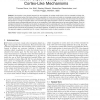Free Online Productivity Tools
i2Speak
i2Symbol
i2OCR
iTex2Img
iWeb2Print
iWeb2Shot
i2Type
iPdf2Split
iPdf2Merge
i2Bopomofo
i2Arabic
i2Style
i2Image
i2PDF
iLatex2Rtf
Sci2ools
105
Voted
PAMI
2007
2007
Robust Object Recognition with Cortex-Like Mechanisms
—We introduce a new general framework for the recognition of complex visual scenes, which is motivated by biology: We describe a hierarchical system that closely follows the organization of visual cortex and builds an increasingly complex and invariant feature representation by alternating between a template matching and a maximum pooling operation. We demonstrate the strength of the approach on a range of recognition tasks: From invariant single object recognition in clutter to multiclass categorization problems and complex scene understanding tasks that rely on the recognition of both shape-based as well as texture-based objects. Given the biological constraints that the system had to satisfy, the approach performs surprisingly well: It has the capability of learning from only a few training examples and competes with state-of-the-art systems. We also discuss the existence of a universal, redundant dictionary of features that could handle the recognition of most object categories. ...
Related Content
| Added | 27 Dec 2010 |
| Updated | 27 Dec 2010 |
| Type | Journal |
| Year | 2007 |
| Where | PAMI |
| Authors | Thomas Serre, Lior Wolf, Stanley M. Bileschi, Maximilian Riesenhuber, Tomaso Poggio |
Comments (0)

